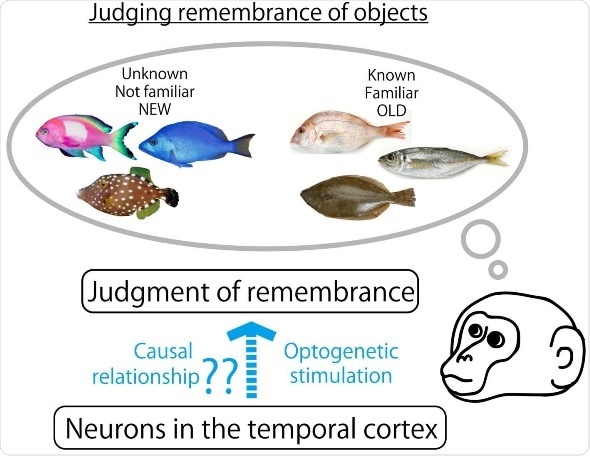Sep 1 2017
Cognitive neuroscience research on non-human primates demonstrated that judgments of whether humans have previously seen or not seen an object are causally determined by neuronal signals generated in the temporal cortex of the brain. The findings are published in Science (August 2017).

Every time we see objects, we judge if we know those objects based on our personal experience. For example, people in Japan would judge the fish widely eaten in Japan (right) as more familiar than the tropical fish (left). In this study, researchers investigated the causal relationship between the neuronal activities in the perirhinal region of temporal cortex and the mnemonic judgment of objects by using optogenetic technology.
“We daily encounter hundreds of visual objects and instantaneously evaluate whether they are safe or dangerous, friendly or hostile, delicious or toxic, or never seen before,” explain Yasushi Miyashita and colleagues at the University of Tokyo School of Medicine and Juntendo University Graduate School of Medicine. While previous studies had shown that visual object memory is related to an area of the brain known as the perirhinal cortex, it was not understood whether and how the neurons in this area causally function in such evaluation (Fig.1).
In early sensory areas, neurons that respond to visual stimuli with similar physical attributes - such as orientation or direction of motion - are found spatially clustered together. In contrast, nearby perirhinal neurons respond to specific memorized objects that can be physically distinct, raising a question whether nearby perirhinal neurons simply convey distinct physical attributes of objects, or convey any non-physical attribute commonly represented among the neurons.
To understand whether and how perirhinal neurons causally function in the recognition of objects, Miyashita and colleagues investigated the behavioral impact of optogenetic and electrical stimulation of the perirhinal cortex in macaque monkeys. In the region where neurons responded to the presentation of previously learnt, that is, OLD objects, both optogenetic and electrical stimulation of neurons increased the probability of the presented objects being deemed OLD (OLD choices). In an adjacent region where neurons did not respond to the OLD objects, electrical stimulation decreased the probability of OLD choices while optogenetic stimulation still increased the probability of OLD choices.
These results suggest that perirhinal neurons do convey a non-physical attribute informing that the encountered object was learned in the past. The researchers propose a possible causal model for the object recognition based on the existence of neurons that selectively respond to specific memorized objects. In that model, the object viewed is deemed old when the activity of these neurons was elevated to reach a certain threshold, while the object is deemed new when the activity failed to reach the threshold.
Background
The techniques to stimulate a small part of the brain provides means of testing certain hypotheses for causal neural mechanism for cognitive processes. One approach is electrical stimulation, where electrical impulses are applied to a region of interest to mimic the electrical signals of neurons. Electrical stimulation activates all types of neurons, including excitatory and inhibitory neurons.
Another approach, optogenetic stimulation, involves genetic engineering of certain types of neurons to express microbial proteins that respond to the light of particular wavelength. The genetically modified neurons then become responsive to the light at this wavelength. A major advantage of optogenetic stimulation is that genetically-defined types of neurons can be selectively manipulated.
Details of optogenetic and electrical stimulation in the perirhinal cortex
In the current study, the researchers identified OLD object-responsive neurons that significantly increased their firing rate when the monkeys were shown specific OLD object images.
To optogenetically stimulate the neurons of the perirhinal cortex, the researchers injected a virus carrying a gene of a light-sensitive protein conjugated with yellow fluorescent protein into the perirhinal cortex. The efficiency of gene expression and neuronal responses to light were confirmed in task-performing monkeys by fiber-optic fluorescence measurements and electrophysiological recording, respectively. The spatial extent, efficiency, and cell-type specificity of the gene expression were gauged by histological analysis.
For the behavioral test, monkeys were shown an image from 20-30 memorized OLD objects, or from 6,000 not-memorized NEW objects with varying levels of pixelated obstruction, and judged whether the presented object was OLD or NEW. Comparison of optogenetic and electrical stimulation showed that optogenetic stimulation that activates output neurons increased the probability of OLD choice regardless of whether or not the stimulated neurons coded OLD objects, while electrical stimulation that activates both output and inhibitory neurons increased or decreased the probability of OLD choices depending on whether or not the stimulated neurons coded OLD objects. The researchers suggest that how the two types of stimulation methods activate different types of neurons may be responsible for this dissociation. The precise mechanisms remain to be further investigated in future studies.
Implications of the current study
The present findings suggest that perirhinal neurons code more than just relay physical attributes of objects, and that they code non-physical attributes of memorized objects as well, such as “learned”. The results will also lead to understanding of the mechanisms of higher mnemonic functions like recognition of semantic values of objects relevant to our life.